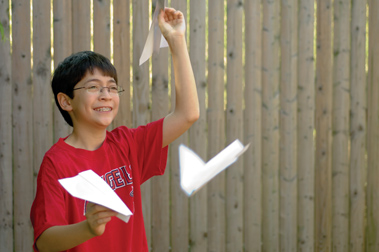






 |
||||
 |
 |
 |
 |
 |
 |
||||
|
S E P T E M B E R 2 0 0 6 I S S U E The Big Question
|
|
|
Ben Lee, 11, is a sixth-grader at McDonogh School and lives
in Pikesville. He collects baseball and football cards, is
a huge Baltimore Ravens and Baltimore Orioles fan, and his
favorite subject is math. He aims to visit every major
league baseball park in the country by the time he
graduates from high school in 2013. He's hit 13 parks so
far. Photo by Will Kirk |

Q:
How Did You Spend Your Summer Vacation? "I went to camps for golf, tennis, filmmaking, and cartooning, and one of my favorite camps was the [Johns Hopkins] Center for Talented Youth, where I took a class in Data and Chance. It was really cool. We did a lot of experiments. We got paper, scissors, tape, and glue and made paper airplanes. Then we analyzed how their weight and length affected the distance the airplanes would fly. One flew 52 feet. "We slip-knotted [a chain of] rubber bands onto Barbie dolls and estimated how many rubber bands it would take to get the doll as close to the ground 493 centimeters below without touching. Then we threw the Barbies off a balcony to see how we did. "We also played the game show 'Let's Make a Deal' using a set our teacher's husband made out of milk cartons. There were three doors. Two doors had paper goats and pigs behind them; one door had a paper convertible. The idea was to figure out the probability that a player would pick the car. When you choose Door #1 as the location of the big prize and the host shows you that the prize is not behind Door #2, you should probably switch your choice to Door #3 because the probability of your winning by switching is two out of three compared to one out of three. "Half of the day we did data sets using measures of central tendency — you know, mean, median, and mode. We did line plots, bar graphs, and box-and-whisker plots using paper and pencils and graphing calculators. We also read a book called How to Lie with Statistics. Now that I know more about probability, I don't fill out entries to drawings that I find in Nickelodeon magazine anymore because I know there's too slim a chance of winning. And the other day in the car, when my dad told me that 30 million kids in China play piano, I told him that he really can't believe that number, and then I told him why. I really like math and I loved learning about probability. It was nice to be with kids who had the same interests as me. There's a one-out-of-one chance I'll take another CTY course next summer." |
 |
|
 The Johns Hopkins Magazine |
901 S. Bond St. | Suite 540 |
Baltimore, MD 21231
The Johns Hopkins Magazine |
901 S. Bond St. | Suite 540 |
Baltimore, MD 21231Phone 443-287-9900 | Fax 443-287-9898 | E-mail jhmagazine@jhu.edu |
|